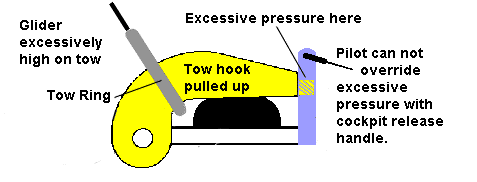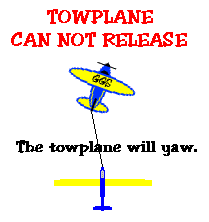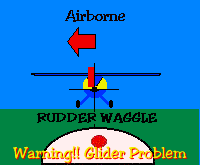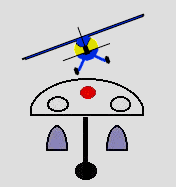Takeoff Emergencies
The key to ensuring successful emergency management is the development of an emergency plan. Prior to takeoff, an emergency release point should be selected somewhere along the takeoff runway. This release point should leave sufficient room to land straight ahead, using normal stopping techniques, in the event conditions are such that a safe takeoff, with the glider in tow, can not be completed. During the initial climb out the pilot of the glider will be noting certain altitudes that correspond to actions he/she will take in the event of a low altitude emergency.
1. Tow Plane Power Failure on the Runway During Takeoff Roll.
- Glider should release or be released by the tow plane and, if possible, maneuver right of the runway.
- Tow plane should maneuver to the left of the runway if space is available. (Realize each individual airfield layout and obstacles may dictate an alternate procedure, so take the time to plan your actions prior to takeoff)
- Survey the abort area carefully and know where you can exit the runway (grass or taxi-way) without causing a hazard. HAVE A PLAN!!
- Realize the glider will probably be airborne, therefore try and give the glider as much space as possible to land on the remaining runway and brake to a stop.
- Know the stopping characteristics of the glider you are towing. Some models have very effective brakes, others do not.
2. Glider Releases During Takeoff with Tow plane Operation Normal
The pilot of the tow plane should continue the takeoff eliminating a collision hazard with the glider.
3. Tow Plane Power Failure or Tow Rope Break After Takeoff But Below 200 Feet Above Ground Level
Should result in the pilot of the glider releasing and descending straight ahead or maneuvering using slight turns to make a specific forced landing area. Because of airport obstructions in close proximity to the airport, the options available for a tow plane or glider land out may be limited. Discuss these options during the pilot briefing or safety meetings. Again, a plan will go a long way in ensuring a successful land out as a result of a takeoff emergency..
4. Once Above 200 Feet
Once Above 200 Feet the glider can more than likely return to the field in the event of engine failure or rope break. Since the tow plane requires considerable more altitude to return to the field, in the event of a power failure, the pilot should have a specific plan in mind that includes pre-selected landing areas for each runway.
5. If the Glider Climbs Excessively High During Takeoff
The tail of the tow plane may be lifted. Should this happen, the application of full-up elevator on the tow plane may not be sufficient to prevent an accident. The tow pilot must be ready to pull the release handle in order to regain control of the tow plane. As a rule of thumb, use of a 200-ft tow line would require the glider to climb to over 20 feet above the altitude of the tow plane to present a danger of upset.

If at any time the nose of the tow plane is pulled uncontrollably by the glider to a dangerously high or low pitch attitude – PULL THE RELEASE! Depending on the installation of the tow hitch, it may be possible for the release mechanism to become jammed due to the excessively high position of the glider (American Style Hook).

Airborne Emergencies Glider Release Failure
If the pilot of the glider is unable to release, the tow pilot should be informed by means of the aircraft radio or by the following airborne signal. The glider will move out to the side so the tow pilot can see the glider, then the glider will rock its wings. Be sure not to mistake the wing rock as the beginning of a normal release. Wait a few seconds to ensure the glider’s wings are rocking.
Once the tow pilot has determined the glider can not release the tow plane should return to the airfield and release the glider at a safe altitude over the field.

Neither the Tow Plane or Glider Can Release
This is an extremely rare event. Although as improbable as this situation may be, we must be prepared. The pilot of the tow plane should inform the pilot of the glider by aircraft radio or airborne signal. The signal is accomplished by yawing the tail of the tow plane.
The glider should move to the low tow position. Then the tow plane should begin a slow descent toward an airfield of suitable length. Fly a wide pattern ending up on an extended final approach. Set up a very stabilized and gradual (200 -300 fpm) descent. Plan on landing long allowing sufficient altitude on short final for the glider to avoid approach obstacles. Since the glider is lower than the tow plane it will land first. The glider should not apply brakes until the tow plane has touch down. After touchdown, apply brakes gently or not at all, slowly coming to a stop. Remember, most glider brakes aren’t that effective, so allow the glider plenty of runway to stop.

While not well defined in soaring literature some glider pilots are taught to attempt to break the tow rope, rather than land behind the tow plane. If the glider does attempt to break the rope, maintain the tow plane in a straight and level attitude in an attempt to reduce the total G forces of the glider’s maneuver. This maneuver is the subject of much controversy and this course recommends landing with the glider in tow as prescribed by the Soaring Society of America’s Soaring Flight Manual. However, as a tow pilot you need to be familiar with all possible scenarios.
Glider Problem
You may notice the glider has a problem that is obviously not being detected by the glider pilot. The most common is the failure of the glider pilot to close and lock the glider’s spoilers/airbrakes prior to take off, resulting in an inadvertent undetected deployment of spoilers as the glider accelerates during takeoff. If you notice a problem with the glider, inform the glider pilot via radio and visual signal. The visual signal for “Glider Problem” is waggling the rudder while airborne.

Immediate Release
This situation requires immediate action by the pilot of the glider. Should the tow pilot rock the wings of the tow plane, the pilot of the glider must release immediately. Obviously, this would be appropriate during a time critical tow plane emergency such as engine-failure, fire, etc.



